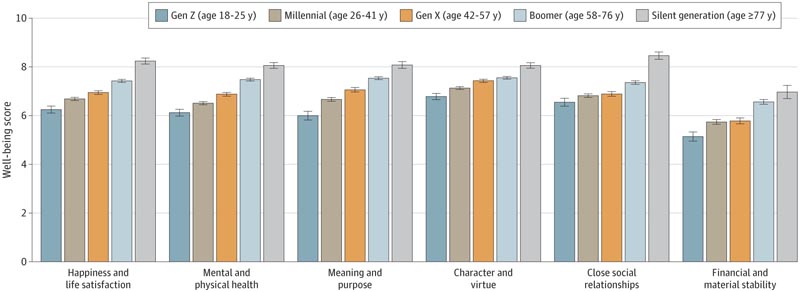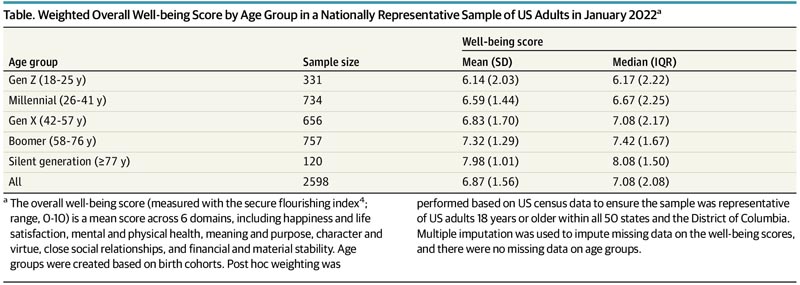There has been growing concern about the well-being of young people in the US, but the evidence has focused on mental health . Taking a comprehensive approach to well-being , we used data from a nationally representative sample of US adults to examine well-being scores by age group across numerous domains.
Methods
The sample for this survey study was drawn from the NORC AmeriSpeak panel , a probability-based panel designed to be representative of the U.S. household population. A stratified sample was selected based on age, race and ethnicity, gender, and education. . Surveys were conducted online and by telephone using a 15-minute questionnaire. Data was collected from January 10 to January 28, 2022.
Based on US Census data, post hoc weighting was performed to ensure the sample was representative of US adults aged 18 years and older in all 50 states and the District of Columbia. Participants responded to a validated 12-item measure of flourishing that assesses 6 domains of well-being, including happiness, health, meaning, character, relationships, and financial stability . Items were self-reported on a scale from 0 to 10. Domain scores were obtained by calculating the mean of the 2 indicators for each domain; The overall well-being score was the mean of the indicator responses across all domains.
Ethical approval was granted by the NORC institutional review board. Participants gave written informed consent. This study followed AAPOR and STROBE reporting guidelines. Analysis of variance and t test (two-tailed) were used to examine group differences by age, race and ethnicity, and gender. Analyzes were performed using SAS, version 9.4.
Results
Of 8618 people contacted, 2598 (30.1%) provided complete responses (1338 [51.50%] women; mean [SD] age, 47.92 [17.94] years).
Well-being increased monotonically cross-sectionally with age for overall well-being, domains, and across individual items (Table and Figure).

Domain-specific well-being scores weighted by age group in a nationally representative sample of US adults in January 2022. Age groups were created based on birth cohorts. Post hoc weighting was performed based on US Census data to ensure that the sample was representative of US adults aged 18 years and older in all 50 states and the District of Columbia. Multiple imputation was used to impute missing data on well-being scores, and there were no missing data on age groups. Error bars represent SE.

Board. General well-being score weighted by age group in a nationally representative sample of US adults in January 2022
Differences between the younger (age 18-25 years) and older (age ≥77 years) age groups were present in meaning (2.08 points; 95% CI, 1.63-2.53), happiness (1 .99 points; 95% CI, 1.60-2.38), health (1.93 points; 95% CI, 1.56-2.31), relationships (1.91 points; 95% CI, 1. 46-2.36), financial stability (1.83 points; 95% CI, 1.23-2.43) and character (1.28 points; 95% CI, 0.93-1.62).
The largest difference in general well-being between age groups was between the youngest and oldest (1.84 points; 95% CI, 1.52-2.15) and was larger than the largest differences among Asians (mean [SD], 6.50 [2.27]), black (mean [SD], 6.76 [1.78]), Hispanic (mean [SD], 6.67 [1.54]), white ( mean [SD], 7.00 [1.50]) and other (≥2 races, non-Hispanic; other, non-Hispanic) (mean [SD], 6.53 [1.21]) race and ethnicity and among men (mean [SD], 6.53 [1.21]) ], 6.87 [1.53]) and women (mean [SD].
Discussion
This study found that mean well-being scores across multiple domains increased cross-sectionally with age, with a substantial age gradient . This finding contrasts with evidence from the early 2000s that showed U-shaped curves for some domains of well-being (e.g., happiness, life satisfaction), with higher well-being scores in early adulthood. and in old age than in middle age.
Our findings support evidence of a mental health crisis and increased loneliness in the US that has disproportionately affected young adults and extend evidence from age gradients to multiple additional facets of well-being beyond of mental health.
Younger adults reported lower well-being even on the self-rated physical health item.
One limitation is that we were unable to separate the effects of age and cohort. More studies are needed to replicate the findings. Although the indicators in the study were obtained by self-report, this was also the case in previous research that documented U-shaped patterns with age
These findings suggest that the well-being of young people has decreased compared to older age groups. Protecting the mental health of young people is considered a national emergency; This study suggests that other facets of your well-being also need attention. Comprehensive strategies are needed to expand mental health services, support education and meaningful employment, and strengthen the social fabric of youth to improve the well-being of this population.
















